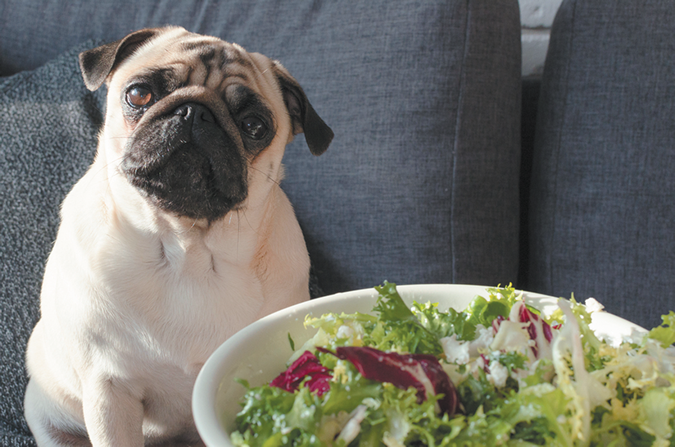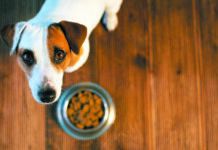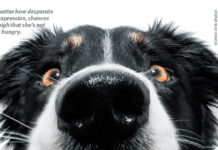

© Alex_Zh | Bigstock
The American Animal Hospital Association has a chart listing things that get in the way of your pet’s weight control. The number one item: begging. Owner guilt is up there, too.
No wonder at least 40 percent of dogs are estimated to be overweight. Pets look at their owners pleadingly with those big beautiful eyes or start whining or whimpering for food. Their owners, in turn, feel bad and give in, letting them have that treat or table scrap.
Chances are you’re one of the softies. But take heart. Making sure your overweight dog sticks to her weight management plan doesn’t require tough love. It just necessitates that you stop using feeding as the sole tool that creates the bond with your pet, and redirect your good feelings for her into more healthful channels. After all, when an overweight dog begs for food, she’s probably not so much hungry as she is bored and looking for attention.
While you give your dog more non-food attention, you can also feed her more often without increasing her calories. The American Animal Hospital Association offers nine ways to maintain and even strengthen your bond with your pet without food and also stretch your dog’s food portions so that it feels to her like she’s getting more even though she’s not.
1. When your dog begs for food, take a brush and groom her — or just play with her. Like toddlers, dogs are pretty distractible. Just calling her away from the food she wants and running a brush through her hair will make her happy. Alternatively, you can initiate a fun game of fetch right in the house that will make her forget about the treat she thought she couldn’t live without.
2. Save a portion of your dog’s meals for treats. While treats don’t completely define your relationship with your pet, they are still important. Your dog won’t notice that a few pieces of kibble were left out of her food bowl, but she sure will appreciate those pieces between meals.
3. Divide food into more frequent but smaller meals. The two-meals-a-day rule is not written in stone. Turn it into three, or even four, smaller meals. She will love the extra mealtime fanfare. Just make sure she’s getting the same amount overall that she would have received in two feedings.
4. Use food as the salary your dog must earn. This doesn’t make you harsh, or mean. It makes you a good teacher, giving your pet the lesson that food happens after she does her work. That work could be anything from completing a series of tricks to going for a walk. It puts the emphasis on adding structure into the day rather than snacking when tedium sets in. It will also make sense to your pet. Dogs need to work for their food in the wild and are hard-wired to engage in this activity. If the work is walking, there’s an added bonus: The American Animal Hospital Association says that “dogs develop stronger bonds with people who walk them than with those who provide food.”
5. Provide environmental enrichment. Give your pet new toys, new games, new walking routes — whatever breaks up her routine so that she can easily anticipate breaks in the day that will remain interesting without feeding.
6. Use food balls and puzzles. This will slow down the eating. Making a game out of retrieving food will also insure that your dog uses her body — and mind — to retrieve her bounty. That, in turn, makes eating all the more rewarding.
7. Encourage exercise with food placement. All the food doesn’t have to go in one spot. Try putting part of each meal in a bowl upstairs, part in a bowl downstairs. Your pet will not be put off. She will enjoy the hunt.
8. Choose low-calorie treats. If your pet is on a weight-management plan and truly feeling a little hungry — or at least not full — what she receives as a treat becomes less important than that she gets a treat at all. Instead of dog biscuits, try low-starch vegetables like cucumbers, broccoli florets, and carrot medallions. That way, she will feel indulged with fewer calories.
9. Keep your pet away from areas where you eat. One of the places dogs are most likely to be overfed is at the kitchen or dining room table. If you make those areas off limits, either through training or with a baby gate, your dog will not have the opportunity to sit in front of you looking as desperate as possible until you give in and relent with some scraps or let her lick your plate.




